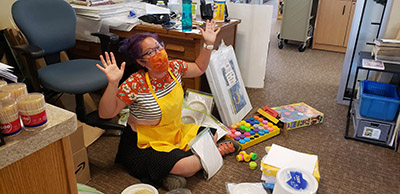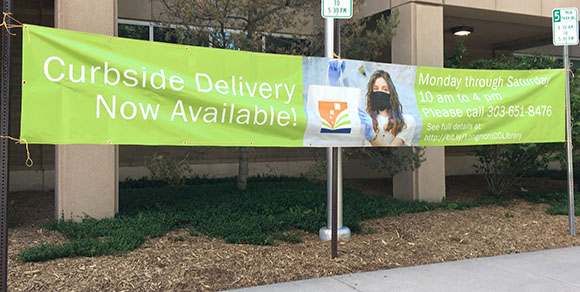This blog post was co-authored by Crystal Schimpf and Linda Hofschire, and is also published on the Colorado Virtual Library blog.
In late May 2020, the Colorado State Library surveyed Colorado public library directors about their responses to the pandemic. We received responses from 76 library jurisdictions (67% of Colorado’s 113 public libraries), as well as two of eight member libraries (25%).*
Here is what we learned about public library services in Colorado during the statewide Stay at Home order (March 26-April 26) and first 35 days of the Safer at Home order (April 27-June 1).
Building Closures
Most public libraries closed their buildings to the public for at least 30 days, and many for much longer.
- During the initial Stay at Home order, 71 of the 78 libraries in the study closed their buildings to the public.
- The remaining seven allowed limited building access during this time. These libraries tended to be small (serving populations of 5,000 or fewer), have one outlet, and were more likely to be library districts.
- Fifteen of the 71 libraries that closed during the Stay at Home order reported opening during the first 35 days of the Safer at Home order.
Alternative & Essential Services
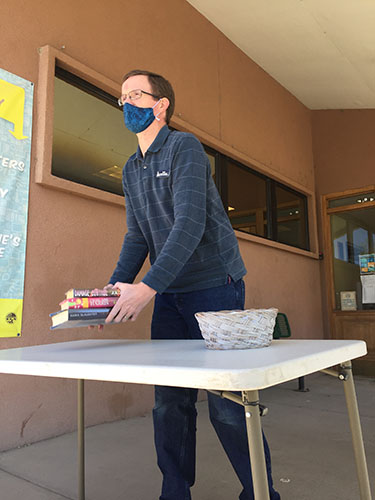
While many buildings were closed during the Stay at Home order and the first 35 days of the Safer at Home order, Colorado public libraries were very much open! Staff responded quickly to the needs of their communities during this time by providing a variety of physical and virtual services. Some of these services were available pre-pandemic, whereas others, such as curbside service and virtual programs, were new for many libraries. One library director responded: “We developed two new services that may be here to stay: Senior Services (dedicated email/chat) for reader’s advisory, questions, etc.; and a Home Delivery service; and Live Chat on the website. The Curbside morphed into “Grab Bags” and a lot of Reader’s Advisory. We have found that many of our new services are very personalized and interactive. Our previous service model was much more passive. The new services are staff intensive and require a lot of work!”
- During both the Stay at Home and first 35 days of the Safer at Home order, libraries that served smaller populations (10,000 or fewer) and were district or county libraries were more likely to offer physical services such as curbside pickup, computer access, and/or home delivery.
- During the first 35 days of the Safer at Home order:
- 9 in 10 libraries offered virtual services such as online programs and reference via phone, email, chat, and/or social media.
- Nearly 9 in 10 libraries also offered curbside pickup, about 3 in 10 offered home delivery, and about 1 in 10 offered mail delivery. Libraries offering home and/or mail delivery tended to be smaller.
- Twenty libraries offered limited or full access to the building, and 18 offered public computer access. These libraries tended to be library districts and serve populations of 10,000 or fewer.
Public libraries cited community need and being a provider of essential services as reasons for providing some services, even when closed due to the Stay at Home order. One library director from a combined school/public library serving a rural area shared their approach: “A closed sign was posted on the Library door with my cell phone number and patrons were encouraged to call if they need books. They would let me know what they wanted & I would meet them outside of the library with their requested materials. Because we are a school library we were available to parents and students when they came to the school to return school [assignments] and pick up new packets. We have one patron who does not own a computer, we did allow that patron to enter the library for computer access. The patron used a computer that was isolated. When finished the computer was sanitized.”
To learn more about how many Colorado public libraries offered various services during the Stay at Home order and the first 35 days of the Safer at Home order as well as how the offerings differed by library size and legal basis (e.g., county, district, etc.), please view this infographic.
Protections for Staff & Patrons
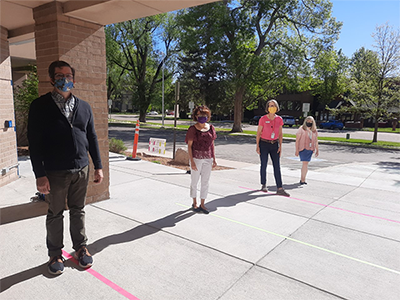
Public libraries showed interest in taking safety precautions to protect staff and patrons, as they considered various approaches to reopening buildings and restoring library services. Nearly all libraries indicated plans for additional cleaning, limiting the number of people in the library, and following social distancing recommendations. In addition to these commonly accepted safety practices during the early stages of the pandemic, libraries were also looking at other ways to provide protection, including reduction of library seating options, installation of plexiglass sneeze guards, and providing additional personal protective equipment for staff. Also, a majority of libraries indicated allowing a telework option for library staff.
One library director expressed how the library planned to provide for public safety: “We have a 17-point plan that we need to comply the best we can. One way-in and another exit is recommended. We are able to do this for most of our buildings. We are quarantining materials and sanitizing them.”
The Colorado State Library recently published guidance (http://www.cde.state.co.us/cdelib/publiclibraryguidancebycovidphase) for public libraries with recommendations for service modifications and safety measures. These recommendations are organized to align with the prescribed levels of precaution based on COVID-19 incidence in the community. This guidance has been drafted in coordination with other statewide agencies, and with input from public library leadership.
Future Research
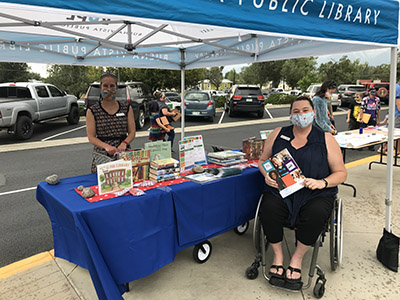 The results of this initial study provided insight into the decision making of Colorado public libraries during a crisis situation, while also raising new questions. At the time this survey was conducted, it was assumed that life would return to normalcy within another few months. At the time of writing this blog post, over three months have passed, and Colorado is still under the same Safer at Home order. As a result of this timeline, libraries have been gradually modifying services, building access, and safety precautions as more information about the virus becomes available.
The results of this initial study provided insight into the decision making of Colorado public libraries during a crisis situation, while also raising new questions. At the time this survey was conducted, it was assumed that life would return to normalcy within another few months. At the time of writing this blog post, over three months have passed, and Colorado is still under the same Safer at Home order. As a result of this timeline, libraries have been gradually modifying services, building access, and safety precautions as more information about the virus becomes available.
We are interested in learning more about how libraries have continued to modify their operations and services and are considering the following topics for a second survey, to be conducted in late Fall 2020:
- How have libraries adjusted the handling of library materials, particularly when returned by patrons, to reduce the potential spread of the virus? How have national research efforts (REALM study) had an impact on decision making about the handling of library materials?
- How did staffing changes impact the restoration of services and reopening of library buildings? Did libraries experience reductions in staffing due to furlough, layoff, resignation, retirement, or temporary leave?
- What new virtual services were developed in response to the pandemic? How have those services been received by the public? Will they continue to be offered into the future?
- What essential services have been provided by Colorado libraries prior to and during the pandemic? How has the demand for these services changed?
What other topics would you like to see covered in a second survey for Colorado public libraries? Please send your ideas to lrs@lrs.org.
*Member libraries are part of a public library jurisdiction but make some decisions autonomously. To view response rates by LSA population category and legal basis (e.g., county, district, etc.), please see this resource.
